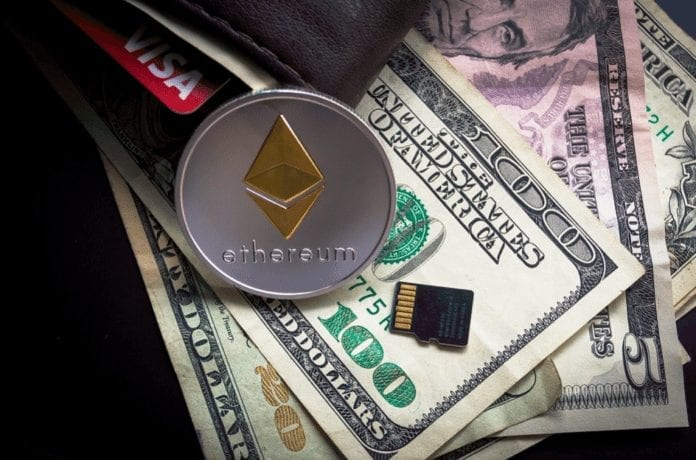While Bitcoin often hogs the spotlight in terms of cryptocurrency and blockchain news, smart investors won’t ignore Ethereum who, although second on the market now, is quickly proving to a strong rival. Ethereum’s potential for significant growth has been discussed in previous articles to include “Bitcoin, Ethereum, Ripple, and Litecoin: The Future of Currency?” and “Why Ethereum Could Hit $4,000 In 2018,” but, today’s Ethereum news reveals not a prediction of future success, but, instead, a clear reason why the future looks bright for the currently “second place” cryptocurrency.
Ethereum is rapidly advancing blockchain technology to handle scaling problems.
Coinbase co-founder, Fred Ehrsam, noted that Ethereum needs to scale by 100-fold to serve a decentralized application with one to 10 mln users. To scale the Ethereum blockchain effectively, both off-chain scaling solutions as well as on-chain solutions are necessary. He explained how “these are hard computer science and game theory problems. Most of them have never been solved before. Estimating completion can be hard and can be far off. Large apps can’t run solely on-chain and likely never will. They need off-chain scaling solutions. While it’s tricky to make accurate estimates when combining scaling improvements, it’s conceivable we could see a 100x improvement by the end of 2018, which would allow a 1–10m user app.”
Plasma is a brand new scaling framework for Ethereum which has the potential to drastically optimize smart contracts and settling financial activities on the Ethereum Blockchain.
It was developed by none other than Vitalik Buterin, the co-founder of Ethereum, and Joseph Poon, the author of the Lightning Network, a micro-payments solution for Bitcoin, in August 2017. Plasma works by optimizing data transferred onto the root blockchain, thereby reducing transaction fees for smart contracts and decentralized applications (DApps).
Plasma’s whitepaper, co-written by Poon and Buterin reads: “We propose a method for decentralized autonomous applications to scale to process not only financial activity, but, also construct economic incentives for globally persistent data services, which may produce an alternative to centralized server farms.”
Plasma is very similar to the Bitcoin Core development team’s scaling solution Segregated Witness, known more commonly as SegWit. Like SegWit, Plasma eliminates unnecessary data in smart contracts and only broadcasts merkelized commitments on the public Ethereum Blockchain.
Decreasing the amount of information and the size of transactions passed on to the root blockchain of Ethereum allows the Ethereum Blockchain to process smart contracts and transactions at lower costs and computing levels.
The white paper further explains how “as only merkleized commitments are broadcast periodically to the root blockchain (i.e. Ethereum) during non-faulty states, this can allow for incredibly scalable, low cost transactions and computation. Plasma enables persistently operating decentralized applications at high scale.”
The official whitepaper mentions many mechanisms to achieve the segregation of data and optimization of information sent to the Ethereum Blockchain.
Most notable after Plasma is zk-SNARKs, a cryptographic system already used by ZCash to prevent double spending without indicating the amounts of ZCash in an account.
According to the paper, zk-SNARKS can also be used to easily provide verification and authentication of complex problems. Similar to how ZCash utilizes the cryptographic system to enhance its security measures anonymously, the Ethereum network can, in theory, construct state transitions (transactions) with zk-SNARKs.
The whitepaper by Poon and Buterin elaborates how: “it is also possible to construct a zk-SNARKs proof of state transitions. For some computational constructions, a bitmap on state transitions may also be necessary in the reduce step (therefore more than one bit can be used per UTXO/account for these use cases). Withdrawals from Plasma chains could be secured by zk-SNARKs which gives the benefit of optionally not requiring the bitmap, which may allow for very small balances to be transferred.”
Vitalik Buterin also presented a Blockchain scaling solution called Plasma Cash; an even “more scalable” version of Plasma.
His presentation was made during a talk live streamed on YouTube at the Ethereum Community Conference in Paris on Friday, March 9. It was developed by Buterin and developers Dan Robinson and Karl Floersch.
Buterin explained the need for PlasmaCash because Plasma requires every user to download and authenticate each Plasma block thereby preventing exponential scaling.
To explain the Plasma Cash model by example, Buterin explained how if a user deposits some amount of ether to a cryptocurrency exchange or third party service, a Plasma coin is created with the same value of ether and a unique, unmutable ID. Plasma Cash, however, would only require users to pay attention to the blocks of specified coins. Buterin noted, “A user actually only needs to verify the availability and correctness of the Plasma chain only […] at the specific index of the coin, of any coins that they own and any coins that they care about.”
Buterin believes PlasmaCash offers cryptocurrency exchanges a way to make themselves more “hack resistant” because of how its code works.
Since each Plasma coin has an owner and is not fully fungible nor interchangeable, no one can access another user’s coin without the proper owner being alerted. The coin’s real owner could prevent a fraudulent withdrawal through the “complaint system” by showing their “proof data” for their coin’s history.

















